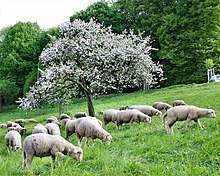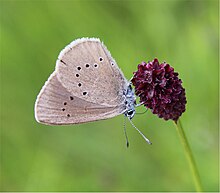Biological station in the Rhein-Sieg district
| Biological station in the Rhein-Sieg-Kreis eV | |
|---|---|
| purpose | Practical nature conservation |
| Chair: | Board of three people |
| Establishment date: | 2002-12-22 |
| Seat : | 53783 Eitorf |
| Website: | biostation-rhein-sieg.de |
The biological station in the Rhein-Sieg-Kreis eV is part of the network of biological stations in North Rhine-Westphalia. Her tasks include the care of protected areas , the collection of basic data on the occurrence of animals, plants and habitats, practical biotope maintenance, species protection and advice to farmers, citizens and authorities e.g. B. in contractual nature conservation . The station itself is an agricultural enterprise and maintains grassland biotopes with sheep. One focus is on the preservation, care and use of orchards .
Sheep farm
The company cultivates over 150 hectares in the Rhein-Sieg district (as of 2019) according to nature conservation standards and uses sheep grazing with Skudden , Moorschnucken and Merino / Schwarzkopf hybrids. The maintenance is financed through funding programs of the state of North Rhine-Westphalia, including contractual nature conservation , and depending on the type of biotope and objectives, various maintenance options are implemented, such as mowing and clearing or grazing.
Old orchards are cultivated, cared for and maintained or expanded with new plantings. For this purpose, new fruit trees are grown and refined with old types of fruit from the region. In this way, the company makes an important contribution to the preservation of old varieties and the diversity of the fruit. The products (juice, fruit brandies, lamb) are marketed regionally.
Species protection
Another part of the work is species protection projects for endangered animal and plant species. Examples include black and red kites , yellow-bellied toad , spadefoot , midwife toad , common wall lizard , Blue butterflies (Darker and Heller Burnet-Large Blues), the vineyard flora and wild herbs. These species are recorded by mapping and strengthened by concrete measures in the population.
Third-party funded projects
The biological station also oversees third-party funded projects. These change depending on the financing period and cooperation. B. in the areas of environmental education, species protection, planning and implementation of compensatory measures.
financing
Via the funding guidelines for biological stations (FöBs), 80% of the station is financed by the state of North Rhine-Westphalia and 20% by the Rhein-Sieg district. In addition, there is income from the agricultural business and third-party funding.
Cooperation partners and donors are u. a. the Sparkassen-Stiftung, the Nordrhein-Westfalen Natur-Heimat-Kultur foundation or the Chance7 project. The Landschaftsverband Rheinland (LVR) supports the biological stations in the Rhineland through the network of biological stations in the Rhineland.


